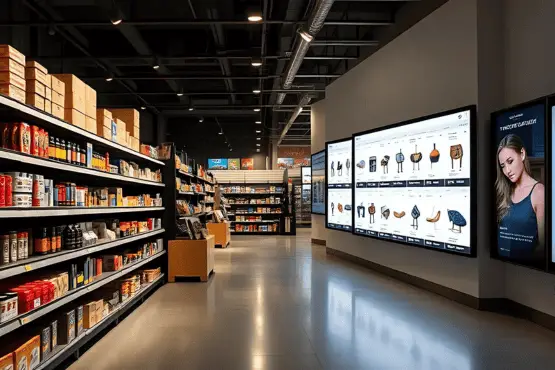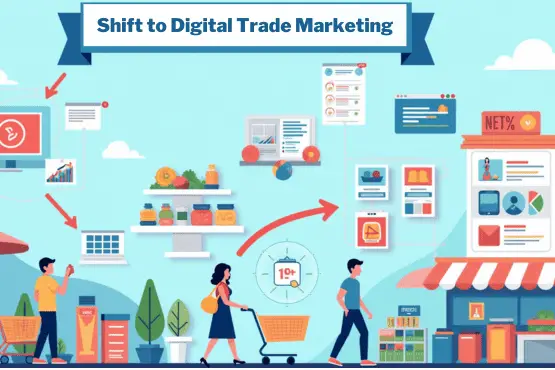Trade marketing, a critical sales and marketing ecosystem component, has recently transformed significantly. This strategic approach, which focuses on increasing demand among supply chain partners and retail customers, has evolved from traditional in-store methods to new digital techniques.
The shift from conventional practices to digital strategies represents a pivotal change in how brands interact with retailers and consumers. This evolution reflects broader changes in consumer behavior, technological advancements, and the rise of e-commerce platforms.
Understanding this transition is crucial for businesses maintaining a competitive edge in today’s fast-paced market. Let’s explore how trade marketing has changed and why this matters for modern companies.
Key Takeaways
- Trade marketing has transformed from in-store tactics to data-driven digital strategies.
- Digital platforms offer improved targeting, measurement, and cost-effectiveness.
- Successful companies are blending traditional and digital approaches
- Future trade marketing will leverage AI, AR/VR, and machine learning
- Adapting to digital transformation is crucial for long-term success
Traditional Trade Marketing Practices
Historically, trade marketing relied heavily on physical presence and direct interactions within retail environments. Key strategies included:
- Merchandising: Optimizing product placement and presentation in stores
- Point-of-sale marketing: Using displays and signage to attract attention
- In-store promotions: Offering samples, discounts, and special deals
While these methods could be effective, they had limitations:
- Difficulty in measuring impact accurately
- Challenges in scaling across multiple locations
- Reliance on manual processes and in-person interactions
For example, Frito-Lay a major snack food brand, launched an in-store sampling campaign in 2010 across 500 supermarkets. While the campaign increased sales by 15% during the promotion period, the company struggled to maintain this growth once the promotion ended. This highlighted the short-term nature of traditional tactics and the need for more sustainable approaches.

Direct Comparison: Traditional vs. Digital
To illustrate the evolution, let’s compare traditional methods with their digital counterparts:
| Traditional Method | Digital Counterpart | Key Differences |
|---|---|---|
| In-store displays | Digital product showcases | Digital versions offer 24/7 visibility and can be updated instantly |
| Printed coupons | Mobile coupons and QR codes | Digital systems provide real-time data, improving efficiency and reducing stockouts. |
| Manual inventory checks | Automated stock monitoring | Digital versions can be optimized in real time based on sales data |
| Static planograms | Dynamic digital planograms | Digital versions can be optimized in real-time based on sales data |
This comparison highlights how digital methods address many limitations of traditional approaches, offering greater flexibility, reach, and measurability.
Shift to Digital Trade Marketing
Several factors have driven the transition to digital trade marketing:
- Changing consumer behavior: Shoppers increasingly research and purchase products online
- Growth of e-commerce: The rise of online marketplaces has created new channels for trade marketing
- Advancements in technology: Digital tools offer new ways to reach and engage customers

This shift has introduced new platforms and tools, such as:
- E-commerce platforms that provide direct access to consumers
- Online advertising networks for targeted promotions
- Data analytics tools for measuring campaign performance
The impact of this digital shift is significant. For instance, a 2022 study by the Food Marketing Institute found that 43% of grocery shoppers now use a mix of online and in-store shopping, up from just 10% in 2015. This change has prompted brands to rethink their trade marketing strategies to encompass physical and digital touchpoints.
Coca-Cola’s Digital Transformation:
In 2021, Coca-Cola implemented a digital trade marketing plan to boost e-commerce and make decisions based on real-time data. The company created digital content for online stores and shared data with retailers. As a result, Coca-Cola saw its online sales jump by 40%, and its trade marketing return on investment increased by 25%. This change shows how digital plans can make a business more productive and help it grow a lot.
Digital Trade Marketing Techniques
Modern digital trade marketing employs a range of sophisticated techniques:
- Omnichannel marketing: Creating seamless experiences across multiple platforms
- AI-powered recommendations: Using algorithms to suggest relevant products
- Automated advertising: Streamlining ad placement and optimization
- Data analytics: Leveraging customer insights for targeted campaigns
- Social media integration: Engaging customers on popular platforms
- Influencer partnerships: Collaborating with key opinion leaders to promote products
These techniques allow for more precise targeting and personalization. For example, a leading consumer electronics brand used AI-powered recommendations on its e-commerce platform, resulting in a 35% increase in average order value.
Case Study: Samsung’s AI-Powered Recommendations
Samsung, a big name in consumer electronics worldwide, put AI to work on its online store to make shopping more personal. This move led to a 35% jump in how much people spent on average. It shows how well AI can boost digital marketing for products by giving shoppers suggestions that fit their tastes.

Contrasting Traditional and Digital Approaches
To further emphasize the evolution, let’s examine how digital techniques have transformed traditional practices:
- Customer Targeting:
- Traditional: Broad demographic targeting based on store location
- Digital: Hyper-personalized targeting using online behavior and purchase history
- Promotional Timing:
- Traditional: Seasonal or pre-planned promotions with fixed durations
- Digital: Real-time, dynamic promotions adjusted based on current market conditions
- Performance Measurement:
- Traditional: Post-campaign analysis with delayed insights
- Digital: Real-time performance tracking allowing immediate optimizations
- Retailer Collaboration:
- Traditional: Periodic meetings and manual data sharing
- Digital: Continuous data exchange through integrated systems
These contrasts demonstrate how digital techniques have revolutionized trade marketing, offering unprecedented precision, speed, and adaptability.
Benefits of Digital Transformation in Trade Marketing
The shift to digital offers several advantages:
- Enhanced customer engagement: Digital channels allow for more interactive and personalized experiences
- Improved measurement: Real-time analytics provide accurate insights into campaign performance
- Cost-effectiveness: Digital campaigns often offer better ROI compared to traditional methods
- Scalability: Digital strategies can be easily adapted and scaled across markets
- Agility: Quick adjustments can be made based on real-time data

Case Study: Walmart Overcoming Digital Adoption Challenges
Walmart ran into trouble when it tried to bring a new digital trade marketing system to its stores. But the company didn’t give up. It trained its staff well and showed how the system worked in smaller shops first. This approach paid off, and within half a year, all Walmart stores were using the new platform. The change had a significant impact: it made promotions 20% more effective. This shows how going digital can make stores run better and help marketing do more with less.
Quantifiable Improvements: Traditional vs. Digital
To concretely illustrate the advantages of digital transformation, consider these comparative metrics:
- Campaign Launch Time:
- Traditional: 4-6 weeks for a nationwide in-store promotion
- Digital: 24-48 hours for a full-scale online campaign
- Audience Reach:
- Traditional: Limited to physical store visitors
- Digital: Potential to reach millions online, including non-store visitors
- Cost Per Impression:
- Traditional: $5-$10 per thousand impressions for in-store displays
- Digital: $0.50-$2 per thousand impressions for targeted online ads
- Data Collection:
- Traditional: Manual surveys reaching hundreds
- Digital: Automated collection from millions of customer interactions
These comparisons highlight the significant improvements in efficiency, reach, and cost-effectiveness of digital methods over traditional approaches.
Challenges in Digital Trade Marketing
Despite its benefits, the transition to digital trade marketing presents several challenges:
- Resistance to change: Many organizations struggle to adapt to new digital processes
- Data integration: Combining data from multiple sources can be complex
- Technological learning curve: Staff may require training to use new digital tools effectively
- Data privacy concerns: Regulations like GDPR and CCPA require careful handling of customer data
- Balancing traditional and digital: Finding the right mix of strategies can be challenging
Companies must invest in training, robust data management systems, and transparent privacy policies to address these challenges. For instance, a major retail chain faced initial resistance when implementing a new digital trade marketing platform. By providing comprehensive training and demonstrating early wins, they achieved full adoption within six months, resulting in a 20% increase in promotional effectiveness.
Case Studies: Successful Digital Transformations
Several leading brands have successfully navigated the transition to digital trade marketing:
Case Study 1: Global Beverage Company
A well-known beverage manufacturer implemented a digital trade marketing strategy focused on e-commerce optimization and data-driven decision-making. Key actions included:
- Developing a dedicated e-commerce team
- Implementing advanced analytics for real-time performance tracking
- Creating digital assets optimized for online platforms
Results:
- 40% increase in online sales within the first year
- 25% improvement in trade marketing ROI
- Enhanced relationships with key retail partners due to data-sharing capabilities
Case Study 2: Consumer Packaged Goods (CPG) Leader
A major CPG company transformed its trade marketing approach by focusing on omnichannel strategies and personalization. They:
- Integrated online and offline customer data for a 360-degree view
- Developed AI-powered tools for personalized promotions
- Collaborated with retailers to create unique digital experiences
Outcomes:
- 30% increase in customer engagement across all channels
- 20% boost in overall sales attributed to personalized promotions
- Strengthened partnerships with top retailers, leading to preferential shelf placement
These case studies demonstrate the potential of digital transformation in trade marketing when executed strategically and comprehensively.
Future Trends in Trade Marketing

Looking ahead, several trends are likely to shape the future of trade marketing:
- Artificial Intelligence (AI): AI will play a more prominent role in predictive analytics, personalization, and automated decision-making.
- Augmented Reality (AR) and Virtual Reality (VR): These technologies will create immersive shopping experiences and innovative product demonstrations.
- Machine Learning: Advanced algorithms will optimize real-time pricing, promotions, and inventory management.
- Voice Commerce: As smart speakers become more prevalent, voice-activated shopping will gain importance.
- Blockchain: This technology may be used to enhance supply chain transparency and build trust with consumers.
- Sustainability Focus: Eco-friendly practices in trade marketing will become increasingly important to consumers and retailers alike.
For example, a furniture retailer is already experimenting with AR technology that allows customers to visualize products in their homes before purchase. This has led to a 35% reduction in returns and a 28% increase in customer satisfaction.
As these technologies mature, companies that adapt quickly will gain a significant competitive advantage. The key to success will be remaining flexible and continually exploring new digital possibilities.
Conclusion
The evolution of trade marketing from traditional to digital methods represents a fundamental shift in how brands interact with retailers and consumers. This transformation offers numerous benefits, including enhanced targeting, improved measurement, and increased cost-effectiveness.
However, the transition also presents challenges, from technological adoption to data privacy concerns. Successful companies effectively blend traditional and digital approaches, leveraging each other’s strengths to create comprehensive trade marketing strategies.
As we look to the future, it’s clear that digital innovation will continue to drive change in trade marketing. Emerging technologies like AI, AR/VR, and machine learning promise to further revolutionize the field, offering new ways to engage customers and optimize performance.
For businesses aiming to thrive in this evolving landscape, embracing digital transformation in trade marketing is not just beneficial – it’s essential. Those who adapt successfully will be well-positioned to build stronger relationships with retail partners, engage consumers more effectively, and drive sustainable growth in an increasingly digital world.
Take Action
To stay ahead in the rapidly changing world of trade marketing:
- Assess your current trade marketing strategies and identify areas for digital enhancement
- Invest in training and tools to build your team’s digital capabilities
- Start small with pilot digital projects and scale based on results
- Stay informed about emerging technologies and their potential applications in trade marketing
- Foster a culture of innovation and adaptability within your organization
By taking these steps, you’ll be well-equipped to navigate the digital transformation of trade marketing and position your business for long-term success.




